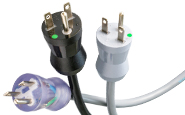Circuit Protection: Selecting the Correct Fuse

When designing a new electronic/electrical product, a critical factor to determine is circuit protection. This protection usually comes in one of two forms: a circuit breaker or a fuse. A circuit breaker is an automatic switch that prohibits the flow of electric current when it is rapidly overloaded or unusually stressed. A fuse is a safety device that protects an electric circuit from excessive current.
“The primary reason for circuit protection is to protect the end user from harm in the event of a fault condition,” explained Dan Ford, Technical Support Specialist at Interpower. “Circuit protection also serves as protection for the equipment itself, especially in products that are highly sensitive and prone to damage by overcurrent fault conditions.” Simply defined, a fault condition is a failure which causes a piece of equipment to draw too much current into the system. This can cause breakdowns, system failures, and possible injury to the equipment user.
One of the first considerations when deciding what kind of circuit protection to use is if the equipment will have a fuse or a circuit breaker (also called a CBE—Circuit Breaker for Equipment). “Both methods work effectively, but between the two options, fusing is the most economical in terms of component costs, the easiest to make changes to if needed during the design stage, and is likely the most recognizable form of protection with equipment designers and users,” Ford said.
However, it’s important to note that there are potential issues with fuses. “One drawback that fuses have in comparison to CBEs is that when a fault occurs, the fuse blows and requires replacement prior to restarting the application. With CBEs, they can be simply reset and the application is up and running again,” Ford explained.
If choosing to use a fuse as the circuit protection option, there are several factors to consider.
Fuse Size and the Equipment Market
There are two standard sizes of fuses used throughout the world: 5 x 20 mm (used worldwide) and ¼ x 1¼ʺ (typically used only in North America). “Where the equipment will be marketed plays an important role in which fuse size should be selected for use. If the equipment will only be marketed in North America, the designer may wish to use the common ¼ x 1¼ʺ fuse, since this size may be more familiar to the customer base,” Ford said. “Products made strictly for markets in Europe, Asia, Australia, etc. need to utilize the 5 x 20mm fuse, as this is the only fuse size users will be able to obtain easily.”
If the equipment will be marketed to both North America and other worldwide markets, then the 5 x 20mm fuse is recommended. This will allow the manufacturer to carry one module or fuse holder/carrier combination and stock a 5 x 20mm fuse. While less common, the 5 x 20mm fuse can be used in North America. This strategy of using a common fuse size when marketing globally will help keep components costs and overhead down.
Current and Voltage Ratings
Another essential factor to determine is the amount of current that will be used in the application when it is running under normal conditions at full load. “This information is vital in choosing the correct current rating for the fuse needed in the application. As a general rule of thumb, it is important to pick an amperage rating for the fuse slightly larger than the value of the steady state current,” Ford said.
“It is also important to verify that the fuses being considered meet the voltage requirements of the application. While many fuses are rated for use up to 250VAC, there are some that only carry a rating of 125VAC. Use of a 125VAC rated fuse in a 240V application could cause the fuse to not work properly and lead to damage to the equipment,” Ford added.
Time-Current Characteristics
A time-current characteristic refers to whether the fuse will open slowly or quickly during an overcurrent situation.
Fast-Acting
A fast-acting fuse will open on overload and short circuits very quickly. These fuses are used in equipment where there are no transient in-rush currents. They offer protection for equipment that cannot withstand current overloads, even briefly. Fast-acting fuses are typically constructed with a single strand of wire or strip of metal.
Time-Delay
Time-delay fuses are designed to withstand a heavy amount of current overload for a limited amount of time. They are used in equipment that can sustain a brief overload situation; typically where loads are inductive, such as equipment utilizing fans, transformers, etc. The construction of time-delay fuses usually utilizes a coiled wire, a thick filament wrapped in wire, or a spring for the element.
Breaking Capacity
“Breaking capacity is also known as the interrupting rating of a fuse. This rating defines the fuse’s ability to safely interrupt and clear shorts or overcurrents, while maintaining the integrity of the body of the fuse,” Ford said.
Breaking capacity covers two categories of fuses: low-breaking capacity and high-breaking capacity.
Low-Breaking Capacity
A minimal ability of the fuse to remain physically intact when overloaded. A low-breaking capacity fuse is readily subject to being physically destroyed if the current surge is great enough.
High-Breaking Capacity
A high level ability of the fuse to remain physically intact even when the overload is great. The fuse is usually constructed with a ceramic body, rather than glass, and filled with silica sand to absorb a large overload and protect the fuse itself.
Heat and Heat Dissipation
Another factor an equipment designer should take into account is the effect of heat in the application. There are two separate parts to consider. ‘The first is the effect of heat from other components on the fuse. If there is a number of other components that produce considerable heat build-up in the vicinity of the fuse and fuse holder, this can have an effect on the type of fuse needed and could cause problems with the performance of the fuse,” Ford explained.
“The other aspect is the heat dissipation created by the fuse and fuse holder during use in an application. It is critical to ensure that combination is not creating too much heat build-up in the vicinity, which could adversely affect both the fuse and fuse holder, as well as the other components in the area,” he said.
Specifications can be obtained to assist in verifying that heat dissipation will not be a problem. Equipment designers need to be aware of this and may need to provide additional heat management techniques within the design of the application.
Fuse Selection
Considering all of these factors can assist in selecting the correct fuse for an application. “Because of the numerous factors that can have an impact on fuse size and performance, Interpower recommends equipment designers obtain samples of the fuse or fuses they think will work best for them and conduct performance testing to ensure the correct fuse size and type is selected,” Ford said.
“This becomes especially important if one is unsure of the amount and duration of in-rush currents and other normal operation surges. In these cases, it may be advantageous to sample several different sizes and types of fuses within a given amperage range and test for the best one,” he said.
Additional Resources
For more information, see Fuses and Fuse Holders and the Featured Product page on Interpower’s website.
Interpower offers free technical support. For further assistance, please see Interpower’s contact information below.






